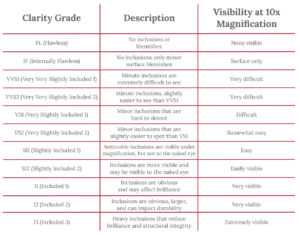Mesmerized by the unique fire of a diamond? Ever wondered why some sparklers command a higher price tag than others? Chances are, diamond clarity holds the key. Just as no two snowflakes are alike, each diamond boasts its own unique fingerprint, with subtle imperfections influencing its overall beauty and value. The diamond clarity scale? Consider it your decoder ring.
This scale offers a standardized way to assess diamonds based on those tiny inclusions and blemishes. These variations impact everything from a diamond’s brilliance to its cost. Before splurging on that dream ring from a top luxury jewellery brand, let’s get acquainted with the nuances of diamond clarity.
What is Diamond Clarity?
Simply put, diamond clarity refers to the absence of internal inclusions and external blemishes. Born from intense heat and pressure deep within the Earth, diamonds almost always showcase minor flaws – nature’s autograph, if you will.
These imperfections can range from barely-there pinpricks to larger crystal formations. While often harmless, they can sometimes interfere with light’s journey through the diamond, dulling its brilliance. Generally, the higher the clarity grade, the brighter, more captivating the diamond. Finding a diamond you’ll cherish from your favourite expensive jewellery brand starts with understanding this aspect.
Who Determines Diamond Clarity, and How to Check it?
The clarity of a diamond is professionally assessed by gemological labs, such as the Gemological Institute of America (GIA) or the American Gem Society (AGS). These labs use microscopes and magnification (typically 10x) to evaluate the number, size, contrast, and position of inclusions and blemishes.
Be sure to check for certifications from reputable labs. They provide detailed reports outlining a diamond’s characteristics.
The Diamond Clarity Scale Explained
Think of the diamond clarity scale as the industry yardstick for assessing a diamond’s purity. Experts rely on it to classify diamonds based on the size, number, location, and type of imperfections visible under 10x magnification. Basically, how “clean” is the diamond?
The scale spans from Flawless (FL), the holy grail of diamond clarity, to Included (I1, I2, I3), where imperfections are easily noticeable and potentially detract from a diamond’s beauty. Grading is a job best left to professionals peering through magnification tools. It’s standard practice at even well-known designer jewellery brands.
The 6 Categories of the Diamond Clarity Scale
Let’s dive into each category:
Flawless (FL)
A Flawless (FL) diamond? That’s the unicorn of the diamond world, incredibly rare and valuable. These diamonds display zero inclusions or blemishes under 10x magnification. Their scarcity allows flawless diamonds to command premium prices, promising maximum light performance. If you’re browsing through famous jewellery brands, keep your eyes open for these. A flawless diamond means serious impact.
Internally Flawless (IF)
Internally Flawless (IF) diamonds are the near-perfect cousins of FL diamonds. They’re inclusion-free, but might have minor surface blemishes that a skilled polisher could buff away. “IF” isn’t quite the same as “FL,” though that’s where people get confused. Still exquisite, IF diamonds often offer a slightly more attainable price point while radiating brilliance.
Very, Very Slightly Included (VVSI1, VVSI2)
VVSI1 and VVSI2 diamonds harbour incredibly minute inclusions, so tiny you’d need high-powered magnification to spot them. Consider them virtually invisible to the naked eye. VVS diamonds provide fantastic value, delivering near-flawless aesthetics without that top-tier price tag. Savvy buyers often hunt for VVS diamonds when exploring high-end jewellery brands.
Very Slightly Included (VSI1, VSI2)
VSI1 and VSI2 diamonds have small inclusions typically requiring magnification to see. Often, you won’t see imperfections in VSI diamonds without magnification, particularly once they’re nestled in jewellery settings. These diamonds strike a sweet spot between clarity and affordability.
Slightly Included (SI1, SI2)
You might be able to see those SI1 and SI2 inclusions without magnification, especially in larger stones or diamonds with centrally located flaws. If you’re considering SI diamonds, give them a close inspection to make sure those imperfections aren’t taking away from their overall sparkle. Extra-cheap SI diamonds might be hiding a more serious issue. When in doubt, get a pro’s opinion, especially when you’re thinking about buying from one of the most expensive jewellery brands.
Included (I1, I2, I3)
Included diamonds (I1, I2, and I3) have imperfections that are plain to see without any equipment. These inclusions could compromise the diamond’s durability and brilliance. Although diamonds are easier on the wallet, a careful evaluation is vital to avoid stones with structural problems. Often, smaller clarity diamonds look just fine in earrings or pendants where size isn’t paramount.
The Diamond Clarity Scale (GIA Standard)
How Diamond Clarity Affects the Price
Unsurprisingly, clarity is a major factor in determining a diamond’s price. The higher the clarity grade (FL, IF, VVS), the steeper the price, thanks to their rarity and visual appeal. The lack of inclusions translates to more unimpeded light, resulting in that breathtaking sparkle desired by collectors. Clarity becomes especially important in larger diamonds, which is a high priority when browsing the top luxury jewellery brands in the world.
Diamond Clarity vs. Other C’s (Color, Cut, and Carat Weight)
Clarity is merely one piece of the “4 C’s” puzzle – Cut, Colour, Clarity, and Carat weight. Together, they define a diamond’s overall beauty and value.
The cut affects how a diamond handles light, influencing its shade. Carat weight dictates its size. Some argue that a well-cut diamond can compensate for lower clarity. But clarity needs to be considered thoroughly when looking at stones.
Common Misconceptions About Diamond Clarity
Here’s a common myth: you need a flawless diamond for a showstopping piece. Not necessarily! The difference between a VVS and an SI diamond might only be detectable under a microscope. Concentrate on a diamond that balances clarity with the other C’s for optimum value.
Understanding diamond clarity empowers smarter purchasing decisions. It’s one piece of a larger picture; personal preferences and budget pave the way toward discovering your perfect diamond.
Choose a diamond that speaks to you, one that captures your heart.
